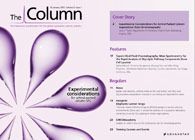Caffeine rush on the high street
Caffeine levels in espresso coffees purchased from coffee shops have been found to vary greatly and at well above the recommended daily allowance set by the Food Standards Agency.

Caffeine levels in espresso coffees purchased from coffee shops have been found to vary greatly and at well above the recommended daily allowance set by the Food Standards Agency.
A study conducted at the University of Glasgow used HPLC analysis of 20 commercial espresso coffees.1 They found six-fold differences in caffeine levels, a 17-fold range of caffeoylquinic acid contents and four-fold differences in the caffeoylquinic acid: caffeine ratio. These variations reflect differences in the bean composition, blending of different beans, roasting and grinding procedures and, most importantly, the amount of beans used in the coffee making process.
These variations mean that consumers, and especially those consumers at risk of toxicity, including pregnant women, children and those with liver disease, are unable to know for definite how much caffeine they are ingesting in a day.
The most caffeine in a single espresso was 322 mg, while a further three contained > 200 mg. The recommended upper limit for pregnant women is 200 mg day−1.
The study concluded that further study on this topic is needed and new data to provide informative labelling to inform the consumer of the way their coffee is being produced.
1. T.W.M. Crozier et al., Food Funct., 2012, DOI: 10.1039/c1fo10240k
This story originally appeared in The Column. Click here to view that issue.
Measuring Vitamin K1 Concentrations in Dogs with Chronic Enteropathy Using LC–MS/MS
May 14th 2025A joint study between the University of Tennessee (Knoxville, Tennessee) and the University of Pennsylvania School of Veterinary Medicine (Philadelphia, Pennsylvania) compared directly measured vitamin K1 (vitK1) concentrations in healthy dogs and dogs with chronic enteropathy (CE) using liquid chromatography tandem mass spectrometry (LC–MS/MS); they also investigated whether supplementation of vitK1 in dogs with CE would significantly increase vitK1 concentrations.
HPLC 2025 Preview: Fundamentally Speaking (Part 2)
May 14th 2025Michael Lämmerhofer from the Institute of Pharmaceutical Sciences, University of Tübingen, Germany, spoke to JFK Huber Lecture Award winner of 2024 Torgny Fornstedt, professor in analytical chemistry and leader of the Fundamental Separation Science Group, Karlstad University, Sweden, about his pioneering work in high performance liquid chromatography (HPLC) with a focus on fundamentals, ion-pair chromatography, and oligonucleotide applications.

.png&w=3840&q=75)

.png&w=3840&q=75)



.png&w=3840&q=75)



.png&w=3840&q=75)









